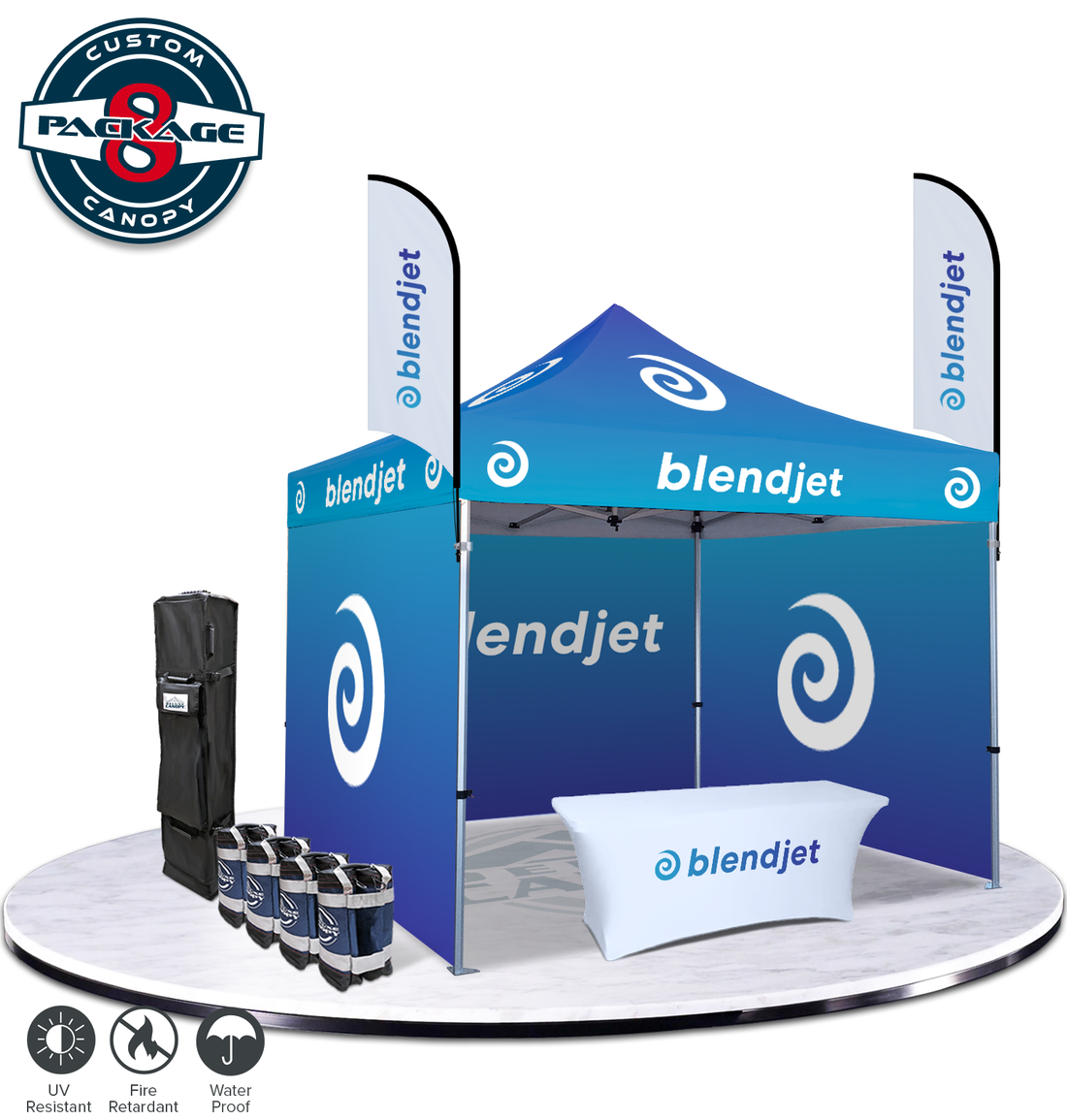Every event has its own vibe, weather risks, and crowd-flow quirks. Pick the wrong tent and you’re battling sagging fabric, chipped graphics, or a frame that wobbles in the breeze. This guide walks you through a simple decision framework—so you can match canopy specs to your exact use-case, budget, and branding goals. For the full ordering workflow, be sure to review our step-by-step guide to buying custom-made canopies for a seamless checkout and production process.
1 · Clarify the Purpose Before You Measure
| Primary Purpose | Ideal Footprint | Must-Have Feature |
|---|---|---|
| Trade-show booth | 10 × 10 ft (standard booth plot) | Dye-sublimated full-bleed roof & valances |
| Outdoor market stall | 10 × 15 ft or 10 × 20 ft | 600 D fabric, zip-on half-walls for airflow |
| Road-tour activation | 13 × 13 ft pagoda or hex frame | Telescopic legs for uneven ground |
| Festival VIP lounge | 20 × 20 ft high-peak | Gutter kits & detachable doors |
Action step: List every venue type you’ll hit in the next 12 months; size your tent to the smallest space so you never exceed floor limits.
2 · Match Frame Grade to Setup Frequency
| Frame Material | Leg Profile | Best For | Average Lifespan* |
|---|---|---|---|
| Steel, 1.25″ square | 30 × 30 mm | Occasional weekend use | 2–3 years |
| Aluminum, 1.5″ hex | 40 × 40 mm | Monthly trade-show circuit | 5–7 years |
| Aluminum, 2.0″ hex | 50 × 50 mm | Daily promo tours & wind-exposed sites | 8 years+ |
*Assumes basic care: dry storage, no dragging legs on asphalt.
Rule of thumb: If you’ll deploy more than 15 times a year, upgrade to aluminum—the weight savings alone reduce crew fatigue and accidental drops.
3 · Choose Fabric Weight for Weather and Print Depth
| Fabric | GSM / Denier | UV Rating | Print Saturation |
|---|---|---|---|
| 420 D polyester | ≈ 150 gsm | UPF 30 | Moderate |
| 600 D polyester (go-to) | ≈ 220 gsm | UPF 50 | Vivid, long-lasting |
| 900 D PVC-backed poly | ≈ 280 gsm | UPF 50 | Ultra-rich, photo-realistic |
-
420 D keeps budgets low but loses color pop after a season of midday sun.
-
600 D balances cost with ink penetration—ideal for most B2B activations.
-
900 D survives desert races and season-long fairs where tents stay up for weeks.
4 · Plan Graphic Zones Around Traffic Flow
| Zone | Viewing Distance | Graphic Priority |
|---|---|---|
| Front valance | 10–20 ft | Full logo + CTA (≤ 4 words) |
| Roof panels | 20 ft+ / drone | Large icon or simplified mark |
| Back wall | Inside booth | Lifestyle photo, product lineup |
| Side half-walls | Close pass-by | Social handles, QR codes |
When you set up on a corner plot, duplicate key artwork on two adjacent valances to catch cross-aisle traffic.
5 · Accessory Checklist by Event Type
| Accessory | Trade Show | Outdoor Market | Sports/Festival |
|---|---|---|---|
| Sandbag weights | ✔ | ✔ | ✔ |
| LED light kit | ✔ | ||
| Awning or merchandise shelf | ✔ | ||
| Rain gutter & side-wall doors | ✔ | ✔ | |
| Hard-case roller bag | ✔ | ✔ | ✔ |
Aim for accessories that bolt on to the same frame brackets—swapping components beats shipping multiple tents.
6 · Real-World Scenario: Non-Profit Roadshow
The eco-charity CleanCoast needed a tent that could:
-
Pop up in 12 state fairs, often on grass.
-
Survive light coastal rain without color fade.
-
Pack into a single minivan.
Solution: 10 × 15 ft 600 D dye-sub aluminum hex-leg + zip-on half-walls. After 18 deployments:
-
Frame shows zero truss bends.
-
Ink ΔE shift < 1.5 (virtually invisible).
-
Setup time averages 12 minutes with two volunteers.
7 · Decision Flowchart
Pin this to your project brief to keep spec creep in check when sales reps upsell extras.
8 · Ordering Timeline at a Glance
| Day | Milestone |
|---|---|
| 0 | Submit quote request with frame + fabric specs |
| 1–2 | Receive 3-D mock-up; request edits |
| 3–4 | Approve color strike-off (overnight courier) |
| 5–12 | Fabric print, cut, sew; frame assembly |
| 13 | Quality check + tracking number |
| 14–17 | Delivery window (ground freight) |
Need more detail? Our step-by-step guide to buying custom-made canopies covers every stage—graphics, payment, shipping tricks, and post-delivery inspection.
9 · Maintenance for Long-Term ROI
-
Dry before bagging—trapped moisture causes mildew that dulls ink.
-
Use pH-neutral soap; avoid bleach that weakens UV coatings.
-
Tighten truss bolts each quarter; loose joints shear in gusts.
-
Store in UV-proof sleeve if the bag rides in open trailers.
Invest five minutes of care after each show—save hundreds on reprints next season.
10 · Wrap-Up & Next Step
Selecting the perfect custom-made tent is a balancing act of purpose, durability, and brand impact. Use the tables and flowchart above to lock your specs, then follow the proven ordering roadmap in our step-by-step canopy guide to avoid costly missteps and hit every deadline with confidence.

